POTA activation of Olallie State Park (US-3239)
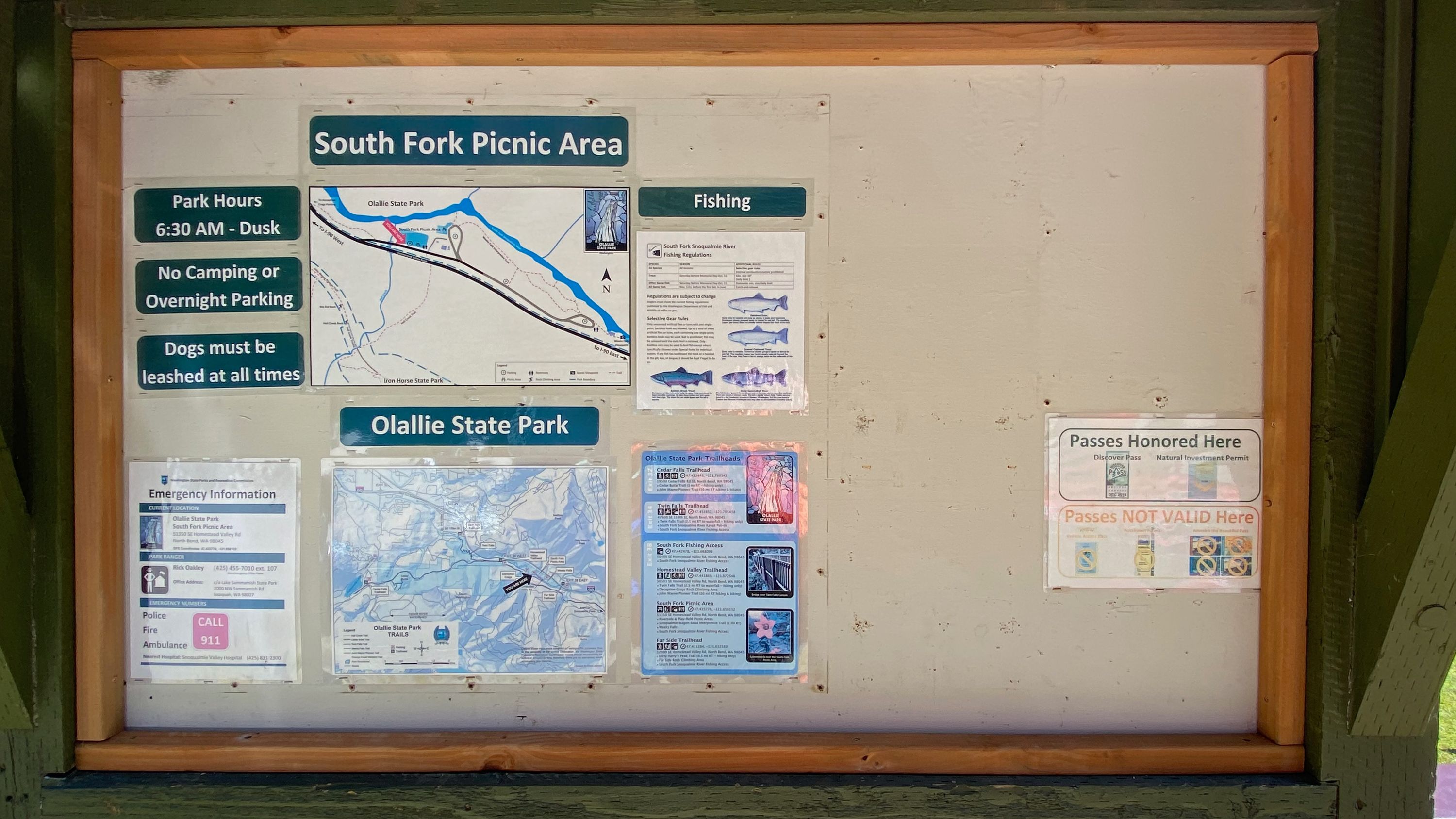
The weather has been wonderful and with pleasant temps and a day free I resolved to head out for a POTA activation or two. Propagation forecasts were not particularly favorable, but my feeling is that I should just head out and see what happens.
After some consideration I resolved to activate Olallie State Park, a little under an hour’s drive away. I’d breezed through the park on the way home from another activation (I don’t remember which one) and recalled that it’s a very nice park, with a picnic area nestled up against a fork of the Snoqualmie river. The biggest problem I foresaw was that the park is also smack in the middle of the Cascade Mountains, so any spot I picked to set up was going to be surrounded by tall walls of rock, which might make for exciting inability to get my signal out.
Site Selection and Setup
I arrived at the park earlier than my usual post-lunch time - about 10:30AM PDT. A bit of driving around helped me decide on my activation site, a picnic table where I could park the car some 35 feet away, had a nice clear area to erect the MC-750 antenna, and would have the option of putting my 30ft fiberglass mast into the drive on mount and using a wire antenna if I decided I wanted to do that. I did consider putting up either a 20m EFHW or an EF non-resonant antenna but in the end the simplicity and speed of setting up the MC-750 won out, and I reserved the wire antenna option for experiment if I got 10 contacts very quickly.
I set up the antenna for 20m, and it took just one tweak to land me with near perfect SWR smack in the middle of the CW portion of the 20m band:
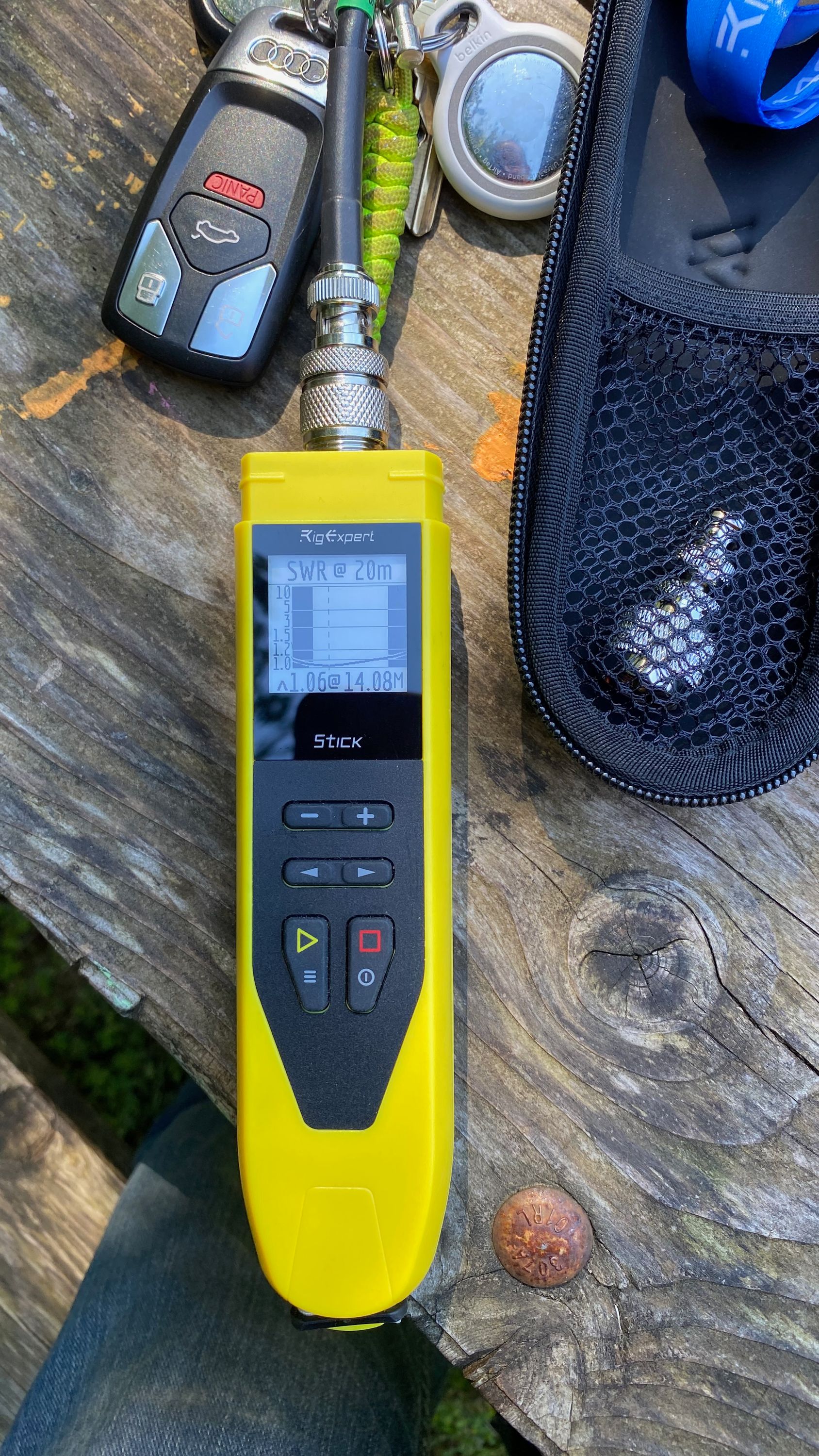
The ground was essentially a few inches of forest duff over glacial till, and my attempts to drive the ground spike for the antenna were hopeless, so I used the little Chelegance tripod.
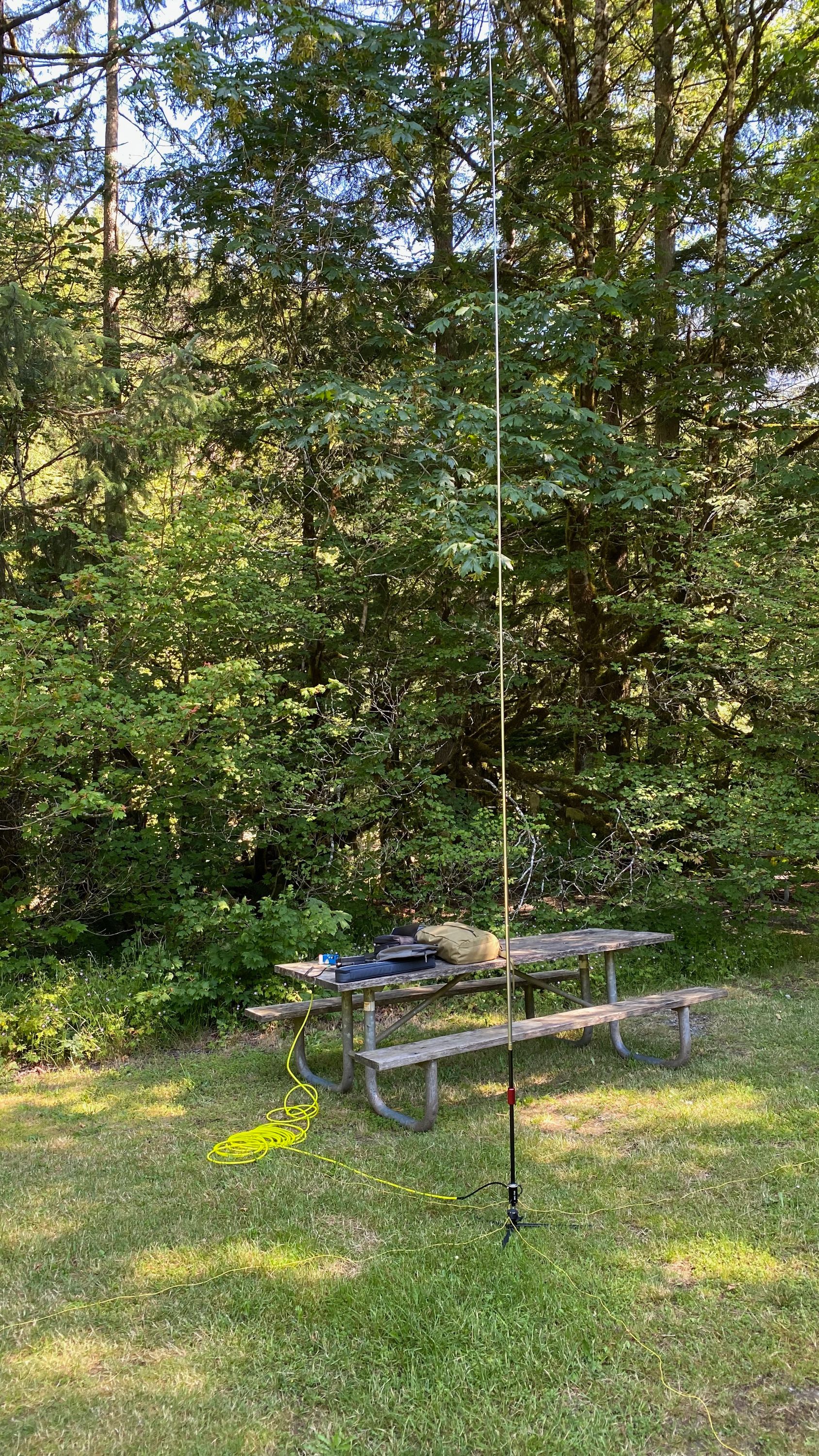
As you can see I had a surfeit of feedline. I’m thinking I want a shorter version of the same thing, perhaps 25 or 20 feet long, just to avoid this ‘heap of coax’ situation which just creates a tripping hazard.
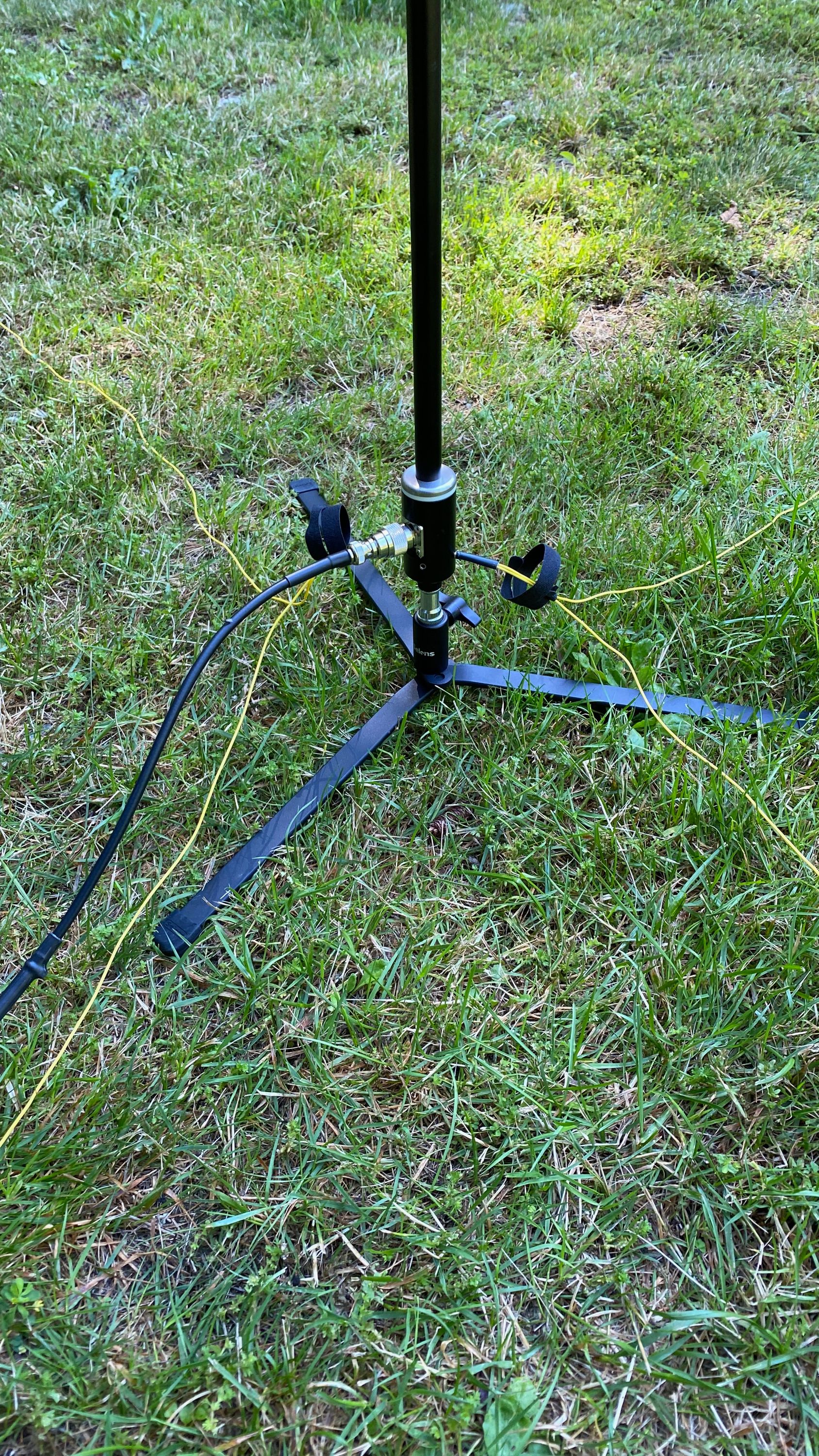
Antenna established, it was a moment’s work to set up the rest of my station:
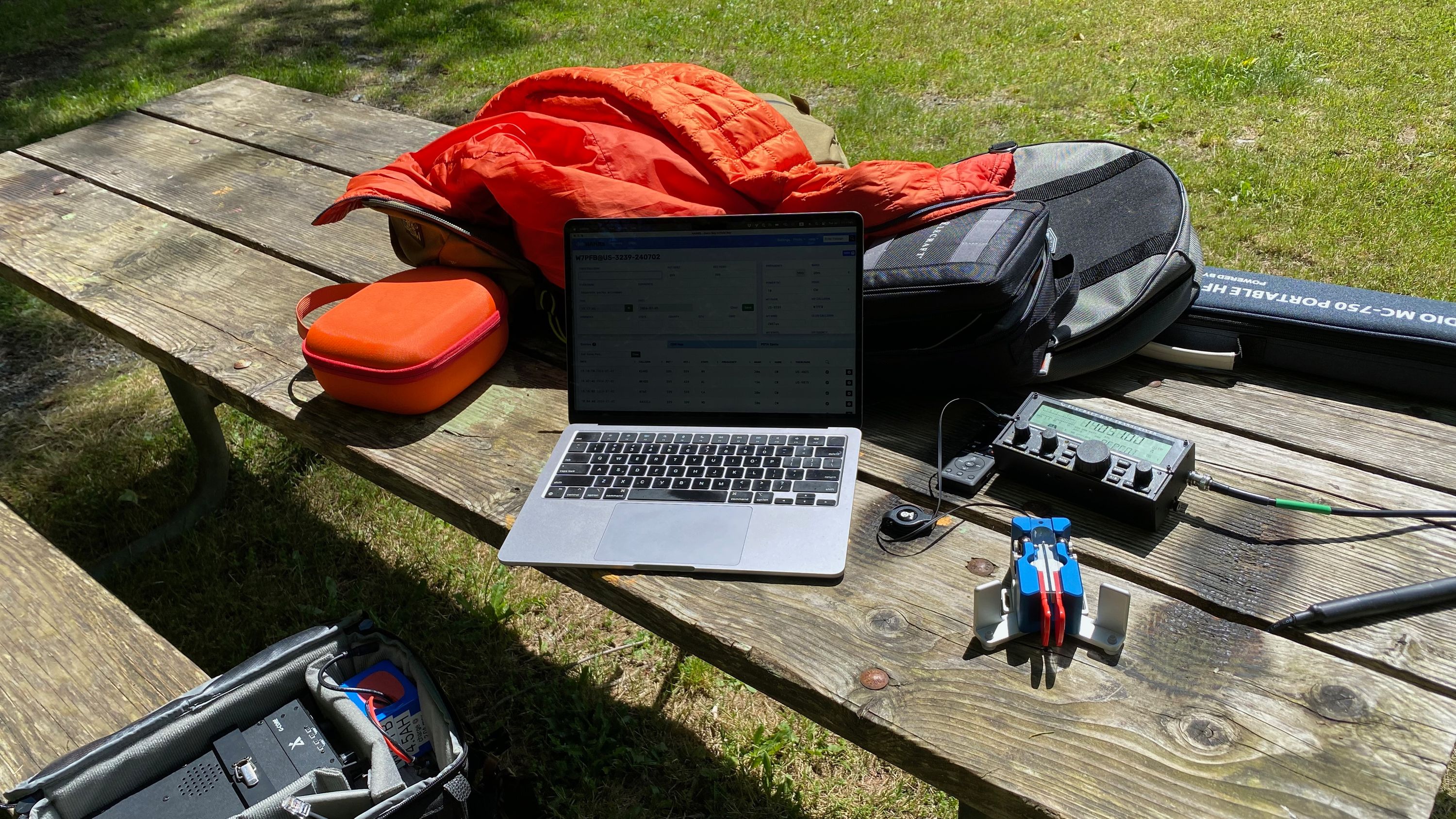
Activation
My first move is now part of my standard procedure, which is to do a little park to park hunting before settling down to call CQ. I managed to hunt WI0S at park US-0362 in MN. I briefly toyed with the idea of chasing some of the many 13 Colonies stations but lots of stations were running massively QRO chasing the event stations (with massive pileups). My chances of breaking through any of the pileups with 5w from the west coast were essentially zip.
I managed to find a quiet frequency, call QRL?, spot myself, and start calling CQ. Cell service in the park is quite good.
Responses came slowly, and the first few callers were very weak. I copies F2KZ, which would be I think in France and doesn’t seem to be in any database I can check, although pota.app accepted it as valid. In any case I gave him/her an RST of 229 - basically ESP required.
Particularly frustrating for me, several stations called with quite strong signals, but then disappeared. It’s still not clear to me whether I just lost contact due to QSB, or they simply grew frustrated with my poor CW skills. A very strong signal that disappears when I have finally figured out their callsign I can attribute to QSB. A strong signal that disappears as I’m struggling to work out the callsign, though, feels very much like a personal failure. I’ve been working hard at callsign copy, but it’s an uphill slog to be honest. Progress is visible, sure, but far slower than I’d like. Regardless, I was struggling with CW decode, which combined with the slow pace was definitely driving the Fun-O-Meter(tm) down.
70 minutes of calling CQ got me up to six contacts, including that initial park to park with WI0S. That’s pretty slow going, so at that point I decided to spend a little time hunting other activators for a bit.
It took me about half an hour to scrounge up 2 more contacts, and then as I was starting to lose hope for getting 10 contacts on CW, I moved over to SSB and the Xeigu G90 at 20W. I hunted up two more contacts park to park, found a free frequency, and started calling CQ. In short order I’d validated the activation. To my great delight, the 10th contact to validate the activation was Laurence, F5PYI, who was in my logs twice from previous activations. One of the things I really enjoy about POTA is QSO’s with hams I’ve come to think of as the ‘usual suspects’, and any time you make a 5200 mile contact on 20W SSB it’s cause for a little celebration.
Whether it was moving from 10W to 20W, or improving band conditions, or even just more hunters being active as it got later, contacts started to roll in, and in fairly short order I had 16 contacts, and then I moved to hunting, and right away bagged K5DGR at US-1225 in CO. At that point, I decided to move back to CW at 10W.
Now the CW contacts rolled in quickly, including (to my great delight) K5DGR working me park to park from US-1225 on 20m, but CW this time, so it wasn’t a dupe. But 20 minutes more calling CQ netted me nothing, and so I rounded things out by working N9JF park to park at US-8169 in SD, and then wrapped it all up.
Some observations
With the kerfuffle with the callsign F2KZ I was not confident that I had a ‘valid’ activation until my 11th QSO, which took place about 2 hours after I started.
I’ve done activations where I hit the ‘valid’ mark in just seven minutes.
There’s a world of difference in how fun the two extremes are, and while I’ll observe that managing a pileup isn’t my idea of a great time, it’s better than listening to the memory keyer drone on with “CQ POTA” non-stop for 15 minutes. Somewhere in the middle is the optimum, which I’ll call ‘maximum fun’.
Second, the second half of the activation was more fun than the first half. Since the contact rate was about the same, it’s not clear to me why, but my sense is that conditions were improving non-stop across the entire activation. To be clear, when I say ‘conditions’ I am talking about propagation and larger footprint for my signal, but also about the size of the pool of hunters, which I suspect is larger in the afternoon than in the morning at 10:30am PDT.
Propagation has not been great of late, and I’m wondering just how much poor propagation is affecting things, how much my reduced power is affecting things, and how much things like local terrain and geography. (I am in the PNW. When N4JAW in Louisville, KY has a 700 mile radius for his signal his coverage area spans from the Atlantic Ocean all the west to Houston. When I have a 700 mile radius, 3/4 of my footprint lies north of the border with in sparsely populated BC and AB in Canada, or in the even more sparsely populated Pacific Ocean, and 1/4 lies in the sparsely populated states of WA, OR, ID, MT, NV, CO, WY, UT)
I’m not saying QRP just doesn’t work here. But I am saying that perhaps if you want to work QRP here in the Pacific Northwest, you are going to need to adjust your expectations and adopt difference working methods, different gear (e.g. better antennas), and not expect to be running a pileup when you’re putting 200mW into your AX1 while sitting inside a picnic pavilion that has a metal roof.
Fun is largely a matter of expectation and you need to adjust your expectations to match the conditions and challenges you face, the gear at your disposal, and your skill set. Mismatches lead to disappointment, either because you couldn’t meet your expectations, or because you hit them so quickly the sense of challenge was lost.
Somewhere in the middle, there lurks a magical sweet spot where it all comes together and maximum fun is had.
Box Score

Total QSOs: 22
Total CW QSOs: 12 (Yay!)
Time spent operating: ~3.5 hours
Battery drain on KX2: 1.50 AH Solo CW bonus points: 12
Things lost: 0
Things broken: 0
Vital gear not included in loadout: 0
Final Fun-O-Metertm reading: 7.6, lower than normal due to CW copy frustrations. Time to practice!

